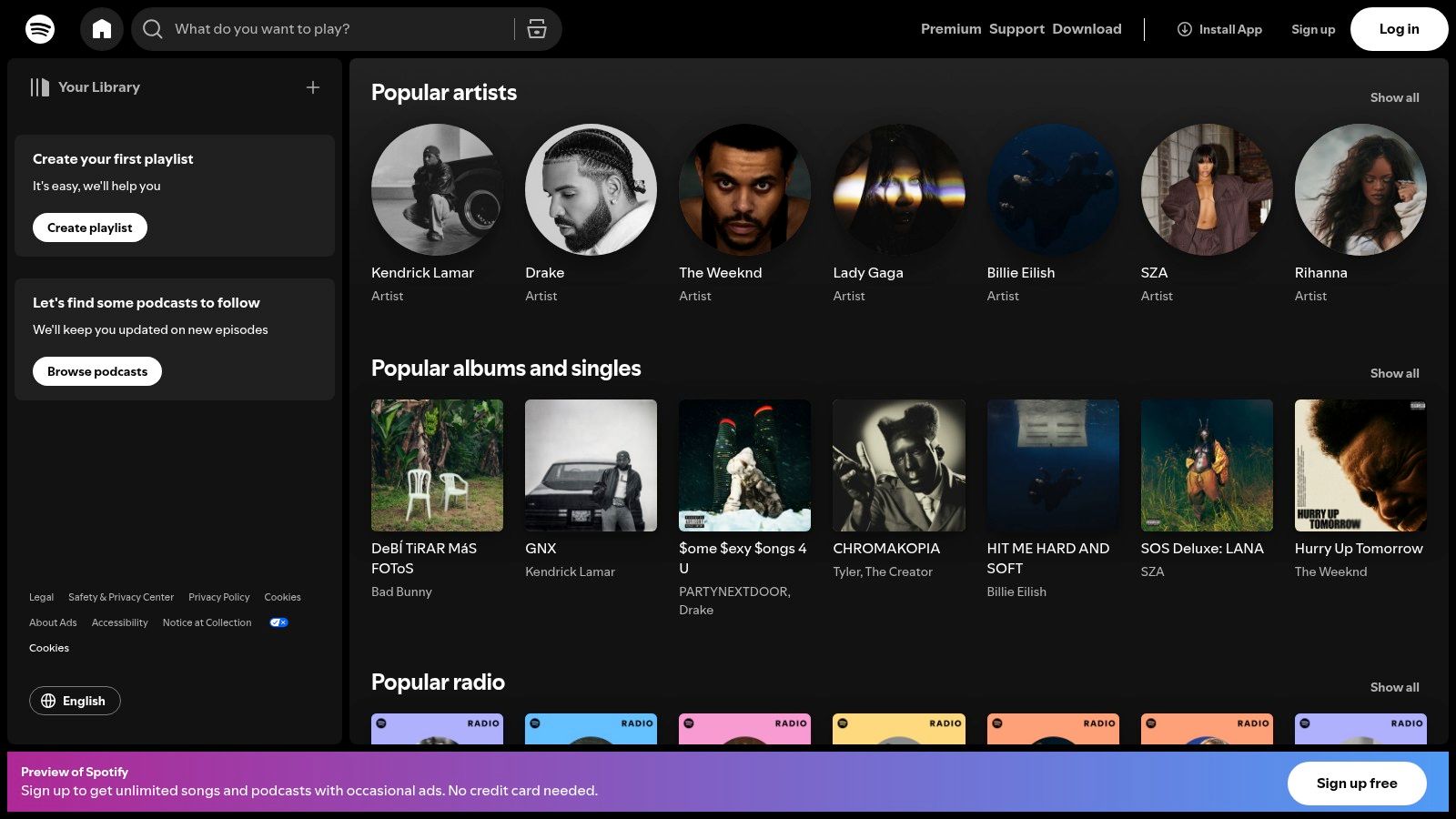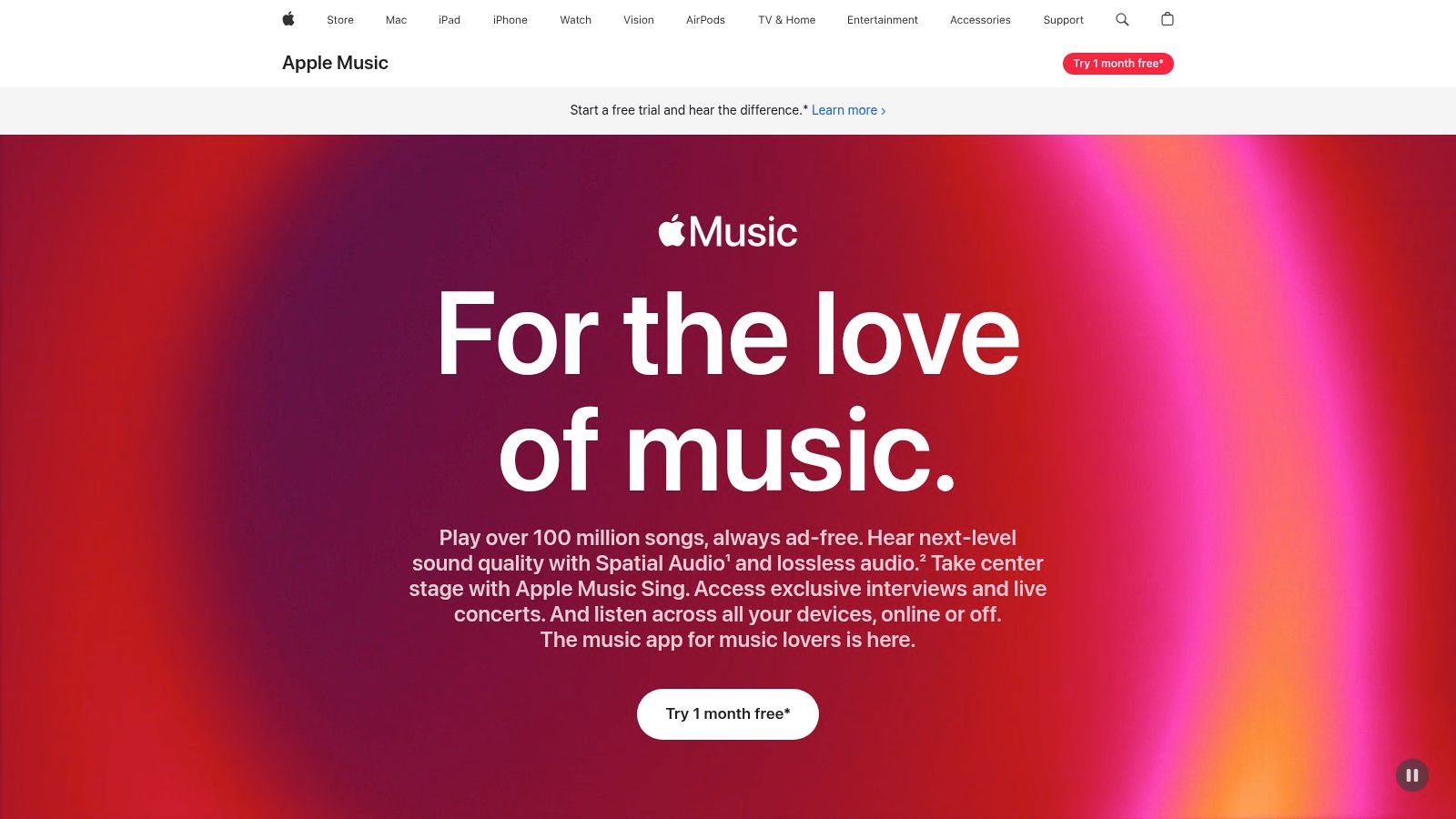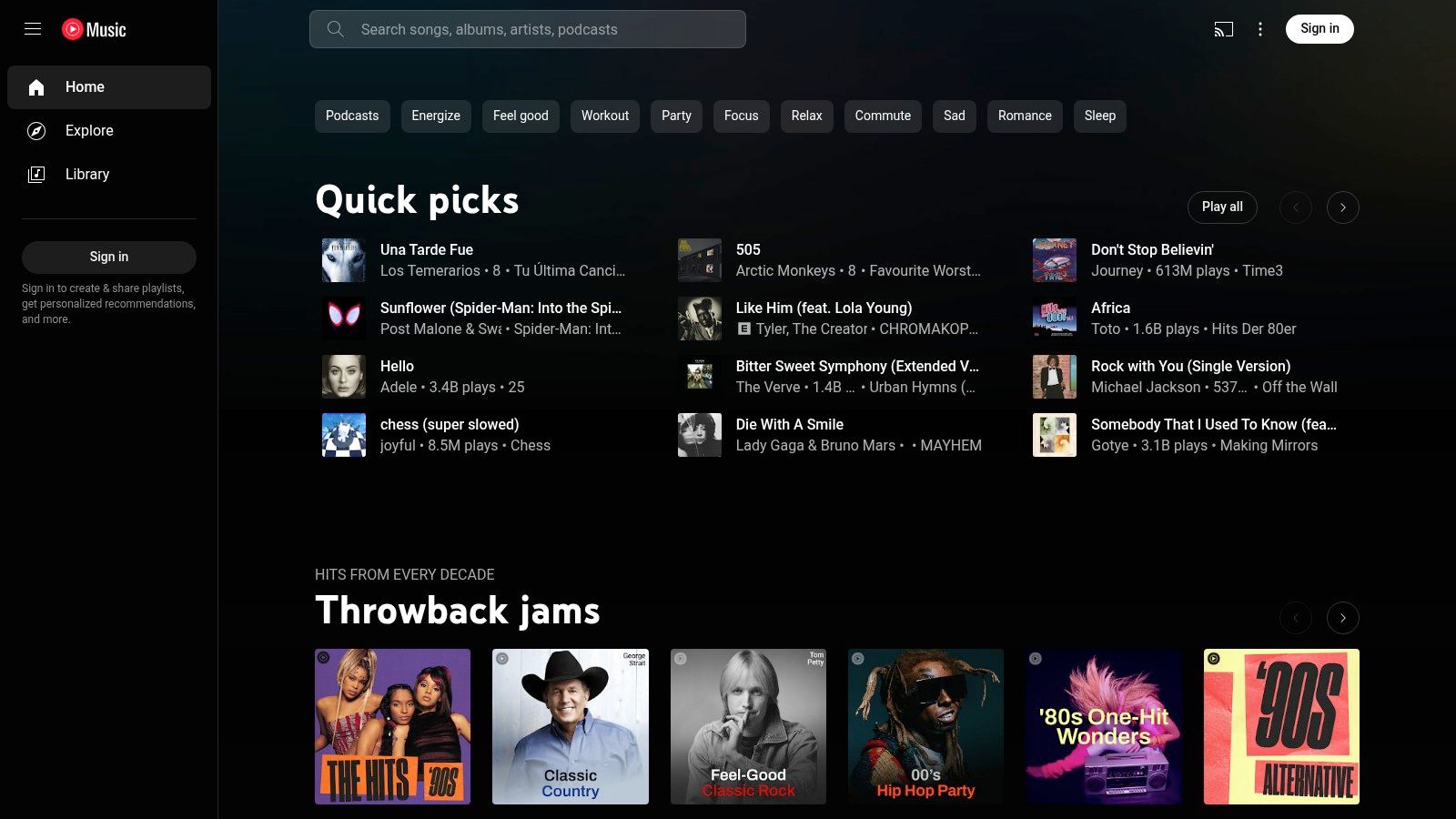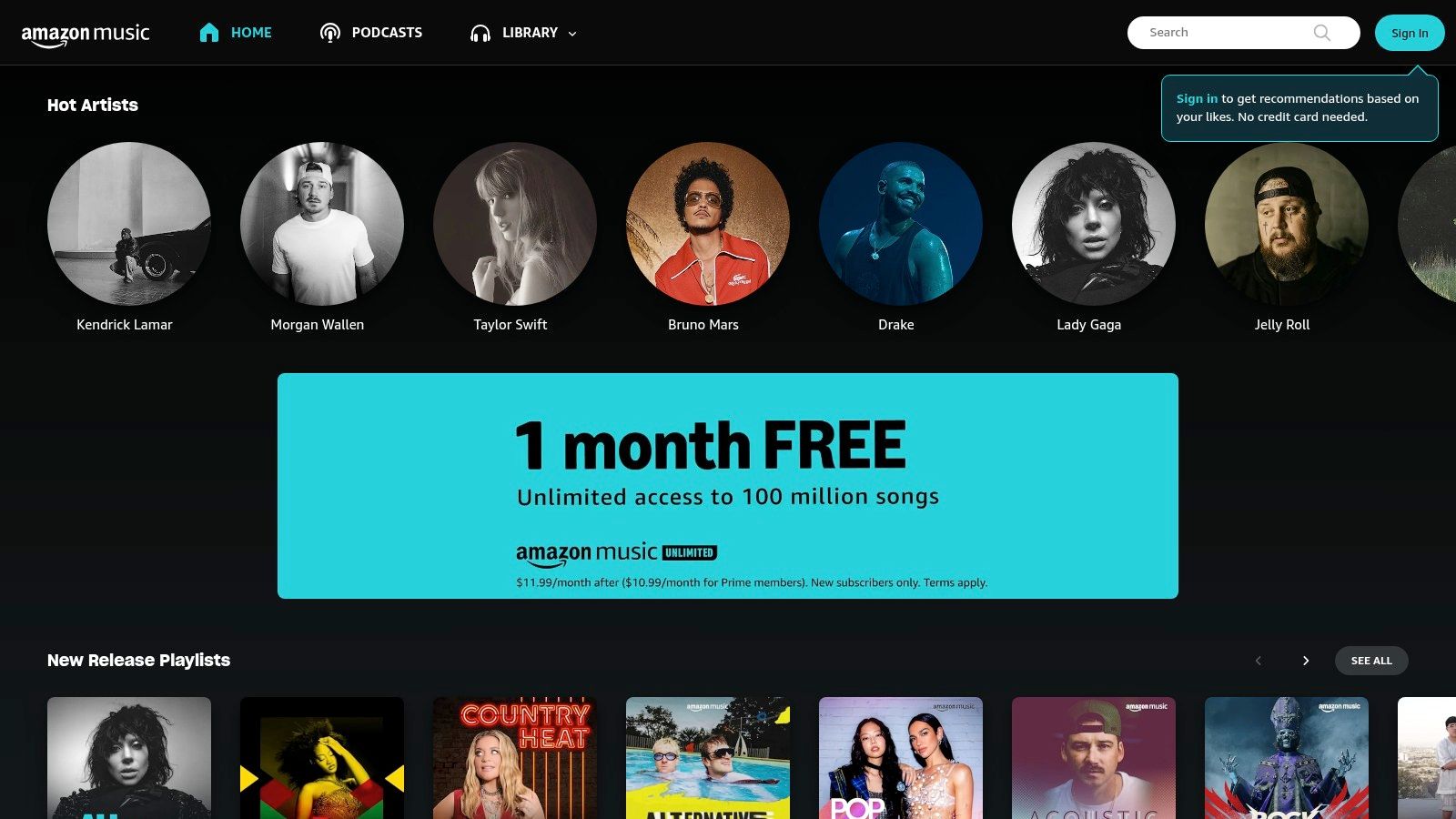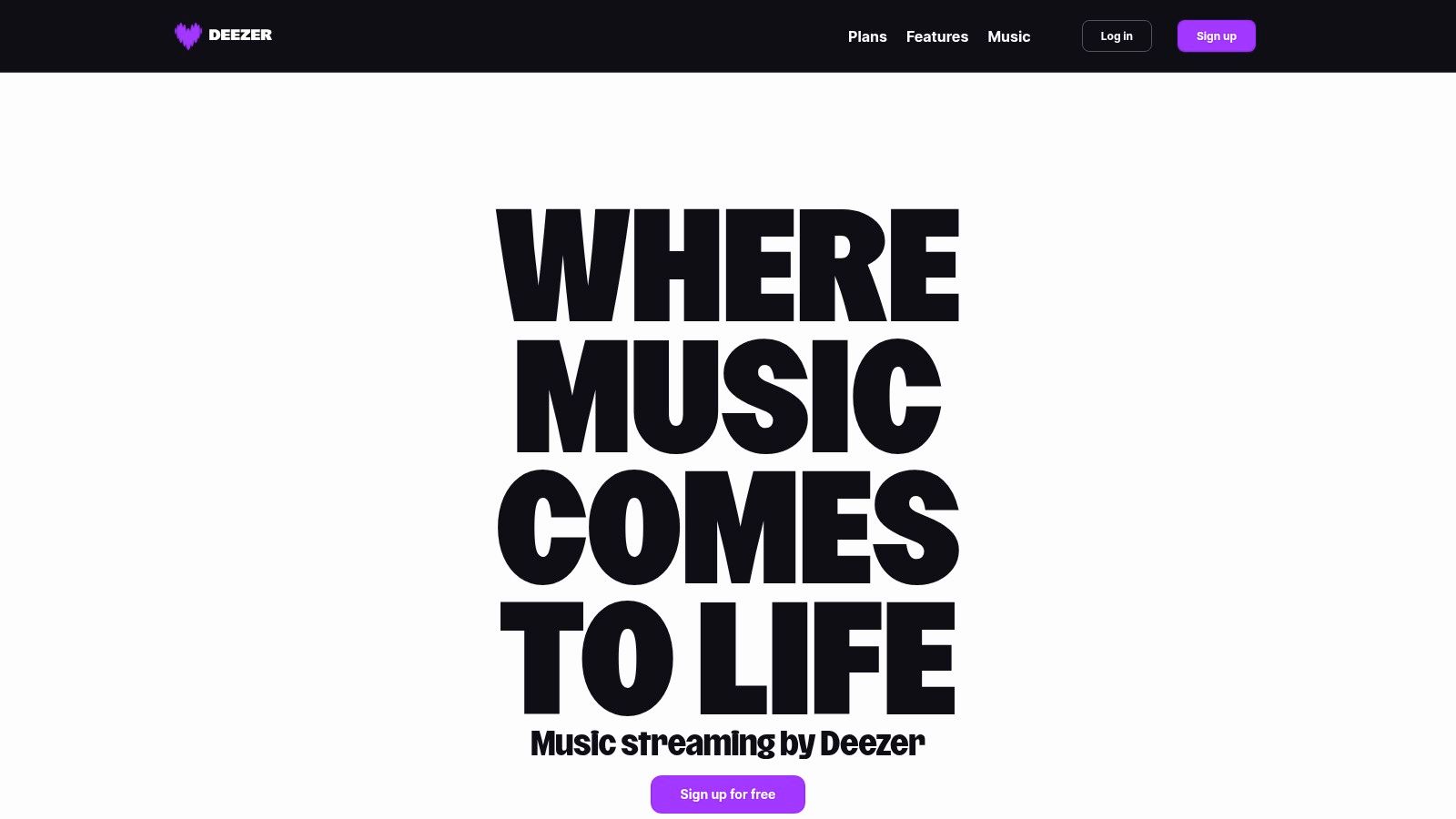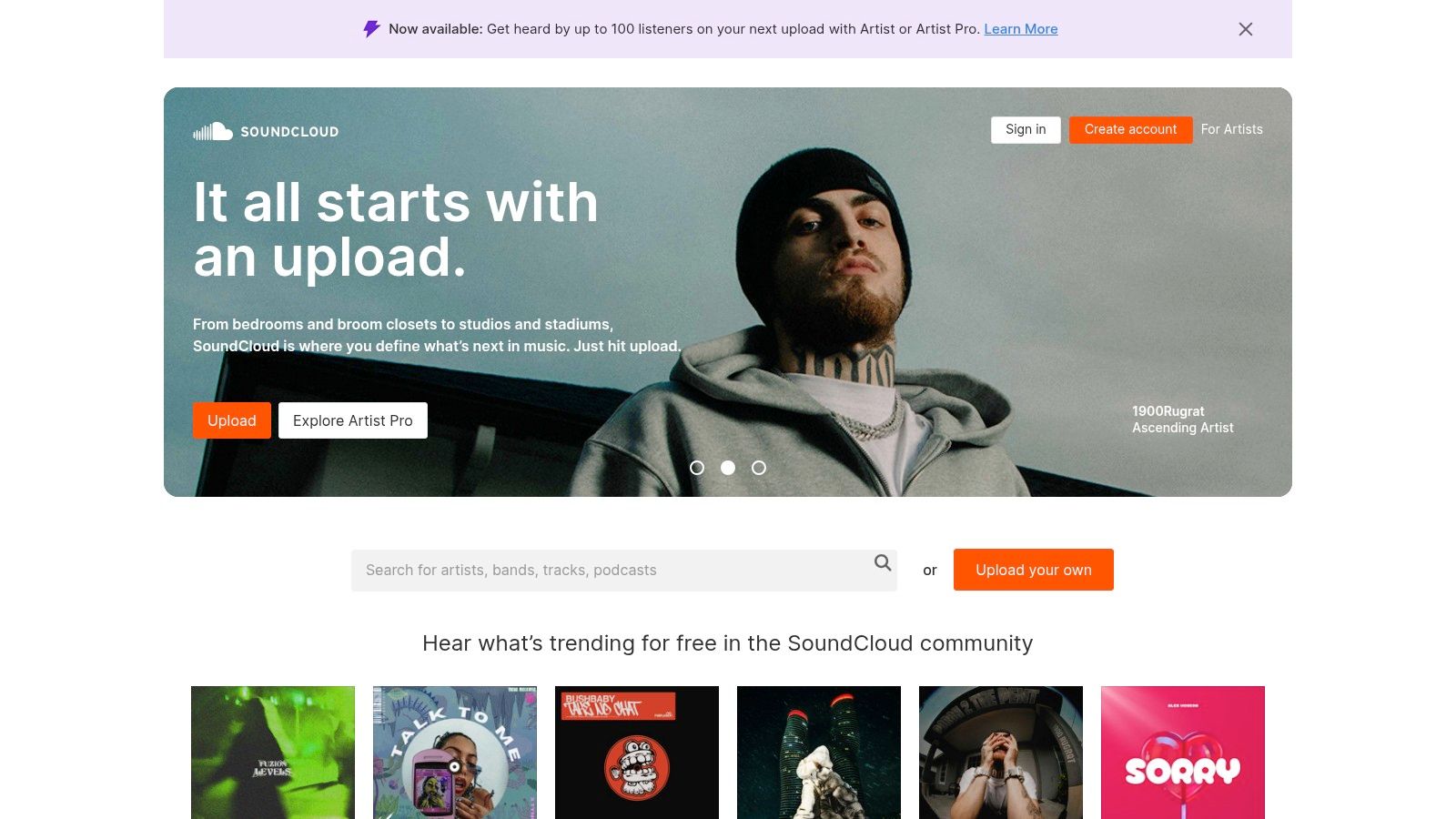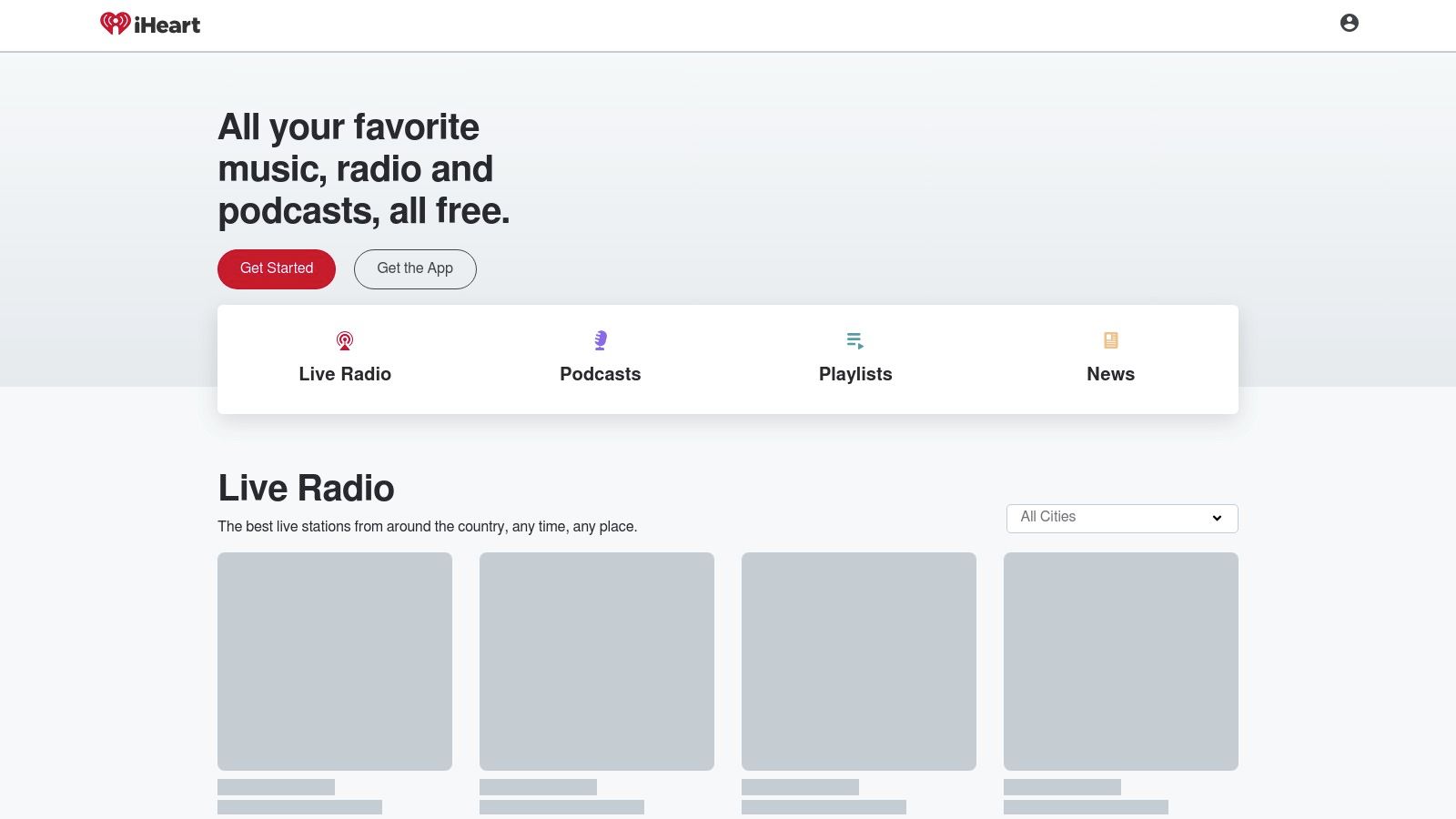Need a New Tune?
Pandora Radio was a pioneer in personalized music streaming, but the music scene has changed. In 2025, you might find yourself wanting more than Pandora's offerings. Perhaps its curated stations feel a bit repetitive, its music library is missing some of your favorite artists, or you're eager to experience higher-quality audio. Finding the perfect music streaming service can dramatically improve your work-from-home productivity, energize your workouts, or simply make your commute more enjoyable. But with a plethora of options, selecting the right replacement can be daunting.
This article explores eight strong Pandora Radio alternatives, each with unique features catering to various needs. When deciding, consider factors like the size of the music library, audio quality, personalized recommendations, offline playback availability, device compatibility, and, importantly, pricing. A good music streaming tool integrates seamlessly into your life, offering an intuitive interface, personalized discovery features, and the music you love, whenever and wherever you want it.
We'll examine the strengths and weaknesses of each platform, comparing free and paid tiers, special features, and any technical aspects, so you can confidently select the perfect soundtrack for your life. Whether you’re looking for background focus music, or are simply a music lover looking for something new, this list has something for everyone.
1. Spotify
Spotify stands out as a top Pandora alternative. With its massive music library, powerful discovery features, and broad device compatibility, it's a compelling choice. Unlike Pandora's radio-style approach, Spotify offers a more flexible listening experience. It combines algorithmic suggestions with on-demand access to over 100 million songs and podcasts. This puts users firmly in control of their audio entertainment.
Spotify seamlessly integrates with various platforms. This includes smart speakers, gaming consoles, and in-car systems, making it especially appealing to tech-savvy users. Businesses can use Spotify for background music or to analyze music trends. Remote workers can take advantage of curated focus playlists and offline listening (with Premium). With such a diverse catalog, Spotify truly offers something for everyone.
Key Features and Benefits
Spotify offers a compelling array of features:
- Extensive Music & Podcast Library: Access a vast library of over 100 million songs and a constantly expanding podcast selection, dwarfing Pandora's offerings.
- Superior Discovery: Spotify's personalized algorithms fuel features like Discover Weekly and Release Radar. These introduce you to new music aligned with your listening habits, providing a more tailored discovery experience compared to Pandora's genre-based approach.
- On-Demand Listening: Choose exactly what you want to hear, whenever you want. Skip tracks, craft custom playlists, and enjoy entire albums without restrictions, unlike Pandora's radio format.
- Social Sharing: Connect with friends, exchange playlists, and discover what they're listening to, building a social element around music.
- High-Quality Audio: Premium subscribers enjoy high-quality audio streaming up to 320kbps for a richer sound.
- Offline Listening (Premium): Download your favorites for offline playback – ideal for commutes, travel, or areas with spotty internet.
Pricing
Spotify provides a free, ad-supported tier and various Premium options:
- Free: Ad-supported listening with some on-demand limitations.
- Individual: Ad-free experience, unlimited skips, and offline listening.
- Duo: Two Premium accounts for couples at the same address.
- Family: Up to six Premium accounts for families residing at the same address.
- Student: A discounted Premium plan for eligible students.
Technical Requirements
Spotify is accessible on a wide range of devices:
- iOS and Android smartphones and tablets
- Windows and macOS computers
- Web browsers
- Smart speakers (Amazon Echo, Google Home)
- Gaming consoles (PlayStation, Xbox)
- In-car entertainment systems
Pros
- Massive music library
- Advanced discovery features
- Robust social sharing options
- Wide device compatibility
Cons
- Free tier has ads
- Artist royalty payments have drawn criticism
- Some exclusive content is locked behind the Premium paywall
Website: https://www.spotify.com
Implementation Tip
Make the most of Spotify's playlist features. Curate playlists for different moods, activities, or genres to organize your music and quickly access what you want. Explore curated playlists and the "Made For You" section to discover new music tailored to your preferences.
2. Apple Music
If you’re deeply invested in the Apple ecosystem and looking for high-fidelity sound, Apple Music is a strong Pandora alternative. Instead of Pandora's radio-style format, Apple Music gives you full control. With a massive library of over 100 million songs, you can listen to practically anything on demand. Plus, you’ll find expertly curated playlists and personalized recommendations. It’s a great option for Apple users, tech enthusiasts, and anyone who wants a seamless music experience.
Apple Music prioritizes audio quality. Lossless audio and spatial audio with Dolby Atmos create a richer, more immersive experience. This appeals to casual listeners and audiophiles alike. Features like Apple Music 1, a live global radio station, offer another way to discover music. The lyrics view allows you to sing along or explore the meaning behind your favorite tracks. Tight integration with Apple devices means easy control across your iPhone, iPad, Mac, and Apple Watch.
Additional Benefits For Professionals
For digital marketers, Apple Music offers a chance to uncover trending music for campaigns. Remote workers will appreciate the vast music selection and personalized playlists to create the perfect work-from-home environment.
While there isn't a free ad-supported version, new users get a free trial. After the trial, various subscription plans are available for individuals, families, and students. You can learn more about different streaming options in our article about Pick Alternative Sitemaps.
Key Features of Apple Music
- Over 100 million songs
- Lossless audio and spatial audio with Dolby Atmos
- Live radio stations, including Apple Music 1
- Lyrics view
- Deep integration with Apple devices
Pros of Using Apple Music
- High-quality audio
- Human-curated playlists
- No ads on any subscription tier
- Seamless Apple ecosystem integration
Cons of Using Apple Music
- No permanently free tier
- Less intuitive for non-Apple users
- Fewer social features compared to some competitors
Website: Apple Music
Apple Music earns its spot on this list by delivering a comprehensive, high-quality music experience deeply integrated with the Apple environment. The lack of a free tier might discourage some, but the premium features and extensive library make it a valuable choice for those seeking a superior listening experience.
3. YouTube Music
YouTube Music earns its place as a strong Pandora alternative, blending traditional music streaming with access to YouTube's vast content library. It's a great option for those already using YouTube and anyone looking for diverse musical content beyond official releases.
Consider it Pandora, but amplified. While offering similar artist- or song-based radio functionality, YouTube Music expands the experience with official tracks, live performances, covers, remixes, and even user uploads. This allows you to discover niche artists, hear unique interpretations of favorite songs, and find content unavailable on other platforms. Imagine finding a live recording of your favorite band's concert, or a fan-made mashup that perfectly blends two different genres. This is the type of discovery YouTube Music unlocks.
For tech enthusiasts, business professionals, digital marketers, and remote workers, YouTube Music offers a versatile audio background. Need focus music? Create a personalized station with instrumental tracks. Want to discover new music while working on a creative project? Explore genre-specific mixes and artist radios. Commuting or traveling? Download playlists for offline listening with a Premium subscription.
Key Features and Benefits
- Access to official tracks and YouTube music content: Enjoy on-demand studio recordings alongside a vast library of live performances, covers, and remixes.
- Smart search using lyrics or descriptions: Can’t remember a song title? Search with a few lyrics or even a general description.
- Personalized recommendations based on listening habits and location: The algorithm learns your preferences and suggests music you might like, even adapting to your location (like suggesting workout music at the gym).
- Seamless switching between audio and video: Listen to a song, then instantly switch to its music video.
- Offline listening with Premium subscription: Download playlists and albums for uninterrupted listening without internet access.
Pros
- Extensive catalog including rare remixes and covers: Discover hidden musical gems.
- Integration with the YouTube platform: Easily transition between music and videos.
- Discovery of new and independent artists: Expand your musical horizons.
- Strong recommendation algorithm: Enjoy personalized suggestions.
Cons
- Free version doesn't allow background playing on mobile: A drawback for mobile users who multitask.
- Audio quality not as high as some competitors: Audiophiles may notice a difference.
- Interface can be less intuitive for music-only users: The YouTube integration can sometimes feel cluttered.
Pricing and Availability
YouTube Music Premium is available as a standalone subscription or bundled with YouTube Premium. Visit the YouTube Music website for current pricing in your region. It's available on web browsers, Android, and iOS devices.
If you’re a frequent YouTube user and enjoy discovering diverse musical content, YouTube Music is a solid Pandora alternative. The free version offers a glimpse of its capabilities, while the Premium subscription unlocks the full potential for seamless, uninterrupted listening.
4. Amazon Music
Amazon Music presents a compelling alternative to Pandora, thanks to its tiered service model that caters to both casual listeners and serious music enthusiasts. Its tight integration with the Amazon ecosystem, especially Alexa, makes it a particularly attractive option for those already invested in Amazon's suite of services.
For current Amazon Prime subscribers, the included Prime Music provides a substantial library of ad-free music. This serves as an easy entry point for exploring the platform. While smaller than the full Amazon Music Unlimited library, it still offers access to millions of songs and curated playlists, making it a valuable addition to the Prime membership. This free tier (with Prime) directly competes with Pandora’s free offering by removing all ads.
If you're looking for a broader selection and enhanced audio quality, Amazon Music Unlimited boasts over 100 million songs, HD and Ultra HD audio, and Spatial Audio with Dolby Atmos. This delivers a significantly richer listening experience than Pandora, especially for audiophiles or those with high-quality audio setups. For true audio quality, Amazon Music Unlimited's lossless audio tiers provide a noticeable improvement. Expect sharper details and a wider soundstage – perfect for focused listening.
Alexa Integration
Amazon Music truly excels in its integration with Alexa-enabled devices. Controlling music playback, managing playlists, and discovering new music becomes incredibly simple with voice commands. This hands-free experience is a game-changer for business professionals and remote workers who want to incorporate music into their workday without disrupting their workflow. Digital marketers can also use this integration for testing audio ads and developing voice marketing campaigns.
Features and Benefits
- Multiple service tiers: Free (with Prime), Prime Music, and Unlimited options
- High-fidelity audio: HD and Ultra HD audio quality
- Immersive sound: Spatial Audio with Dolby Atmos
- Voice control: Seamless Alexa integration
- Sing along: X-Ray lyrics
- Curated content: Playlists, stations, and podcasts
Pros and Cons
Pros:
- High-definition audio options
- Included with Prime membership (limited catalog)
- Deep integration with Echo devices
- Competitive pricing with various tiers
Cons:
- Full catalog requires Unlimited subscription (currently $8.99/month for Prime members, $9.99/month for non-Prime members)
- Mobile app interface could be improved
- Music discovery features not as robust as Spotify
Implementation/Setup Tips
- Download the Amazon Music app on your devices.
- Link your Amazon account.
- If you have an Alexa-enabled device, ask Alexa to play music from Amazon Music.
- Explore the curated playlists and stations to find new music.
Website: https://music.amazon.com/
Amazon Music offers a compelling combination of convenience, affordability, and high-quality audio. While its music discovery features may not be as advanced as some competitors, its close integration with the Amazon ecosystem and flexible pricing structure make it a strong option for those seeking a Pandora alternative.
5. Tidal
If Pandora's radio-style format leaves you wanting more control, Tidal might be the perfect alternative. This platform sets itself apart with a commitment to high-fidelity audio and a business model that prioritizes supporting artists. Unlike Pandora, Tidal focuses on on-demand streaming, letting you choose exactly what you want to hear, when you want to hear it. This makes it a great option for audiophiles, music professionals, and anyone who values superior sound.
Tidal offers two main subscription tiers based on audio quality: HiFi and Master Quality Authenticated (MQA). HiFi provides lossless CD-quality audio, delivering a crisp and clear listening experience. MQA, on the other hand, provides studio-quality sound, replicating the original recording as closely as possible. This focus on high-fidelity audio distinguishes Tidal from many other streaming services that use compressed audio formats. You might be interested in: Our Sitemap for other helpful resources related to choosing the right tools.
Beyond audio quality, Tidal boasts a library of over 90 million songs and 450,000+ videos. This includes exclusive content, artist interviews, and early releases you won't find anywhere else. Its human-curated playlists offer a more personalized discovery experience than Pandora’s algorithm-driven radio stations. Tidal also offers a more equitable compensation model for artists than many other platforms, making it a compelling choice for both creators and consumers.
Features
- HiFi and Master Quality Authenticated (MQA) audio options
- Over 90 million songs and 450,000+ videos
- Exclusive content and early releases
- Human-curated playlists and music discovery
- Direct artist support model
Pros
- Superior audio quality for discerning listeners
- Artist-focused business model
- Extensive editorial content
- No advertisements on any tier
Cons
- Higher price point than standard streaming services (HiFi: $9.99/month, MQA: $19.99/month)
- Smaller user base for social features
- No permanent free tier available (occasional free trials offered)
Implementation Tip
Invest in a good pair of headphones or speakers to fully appreciate Tidal’s high-fidelity audio. The difference between standard quality and lossless/MQA is significant, especially with high-quality audio equipment.
Tidal earns its place on this list by catering to a specific niche: listeners who prioritize sound quality and supporting artists. While the higher price point might not suit everyone, the premium audio and exclusive content make it a strong alternative to Pandora for serious music enthusiasts.
Tidal
6. Deezer
Deezer stands out as a solid alternative to Pandora because of its vast music library and personalized "Flow" feature. While Pandora shines with its radio-style streaming, Deezer provides a more complete experience. It offers on-demand access to over 90 million tracks and podcasts. This makes it perfect for those wanting greater control over what they listen to. Think of it as a combination of Pandora's discovery features and Spotify's on-demand access.
Deezer's "Flow" acts like a personal DJ, creating a continuous music stream tailored to your listening history. Like Pandora stations, Flow adapts and learns over time. However, Flow also lets you skip, rewind, and choose specific tracks. This provides a more interactive experience, especially for focused work where the constant surprises of radio might be distracting. For digital marketers seeking background music for video content, or professionals needing a curated playlist for a presentation, Flow delivers the needed flexibility and control.
High-Fidelity Audio and Other Features
Beyond Flow, Deezer offers high-fidelity audio options. The HiFi tier provides lossless audio quality, creating a richer, more detailed listening experience. This is a major plus for remote workers who may use high-end headphones and want the best possible sound during breaks.
Features:
- Over 90 million tracks and podcasts
- Flow personalized music stream
- HiFi lossless audio option
- SongCatcher music identification
- Lyrics integration and music sharing
Pros:
- Extensive global presence with local music catalogs, appealing to a diverse user base.
- High-quality audio, including HiFi for discerning listeners.
- Intuitive music discovery with the Flow feature, blending personalized radio with on-demand selection.
- Lyrics available for most songs, ideal for karaoke or simply following along.
Cons:
- Smaller user base in the US compared to platforms like Spotify or Apple Music.
- The mobile app can occasionally experience performance issues, sometimes interrupting playback.
- Certain features, like HiFi audio, require a premium subscription.
Pricing and Technical Requirements
Deezer has both free and premium plans. The free version includes ads and limited skips. Premium plans vary based on features and location, typically offering ad-free listening, offline playback, and higher-quality audio. Visit the Deezer website for specific pricing details.
Deezer is compatible with a wide array of devices, including iOS, Android, Windows, macOS, web browsers, and smart speakers. Specific requirements vary but generally include a stable internet connection for streaming.
Implementation/Setup Tips:
- Download the Deezer app or access it via a web browser.
- Create an account or log in.
- Start listening to Flow or explore different genres and artists.
- Customize your Flow by liking and disliking tracks to refine recommendations.
Website: https://www.deezer.com/
7. SoundCloud
SoundCloud distinguishes itself as a Pandora alternative by offering a refreshingly different approach to music discovery. While Pandora leans on algorithmic radio based on well-known artists, SoundCloud thrives on a community-driven model. This model emphasizes independent creators and exclusive content.
This focus makes SoundCloud ideal for those wanting to explore niche genres and emerging artists. It also provides a platform for engaging directly with the music community.
Think of SoundCloud less as a radio replacement and more as a social audio platform. With over 300 million tracks, including remixes, DJ sets, and underground music often unavailable on mainstream services, SoundCloud is a treasure trove for adventurous listeners. You can delve into personalized recommendations, follow favorite artists, curate playlists, and repost tracks to share with followers. The platform’s unique commenting system allows for timestamp-specific feedback, fostering direct connections between artists and fans. SoundCloud also provides monetization opportunities for artists, making it a viable platform for career building.
SoundCloud offers a free, ad-supported tier for accessing its vast library. For an enhanced experience, SoundCloud Go and Go+ subscriptions unlock ad-free listening, offline playback, and higher quality audio. While the free tier's audio quality isn't comparable to dedicated HiFi services, the premium tiers offer a significant improvement.
Features
- Over 300 million tracks, including independent and exclusive content
- Community platform for artists and listeners
- Track commenting and feedback system
- Artist monetization opportunities
- Playlist and repost capabilities
Pros
- Unique content unavailable on other platforms
- Direct connection between artists and fans
- Strong underground and emerging artist presence
- Accessible platform for new artists
Cons
- Audio quality not as high as specialized HiFi services like Tidal
- User interface less polished than major competitors
- More limited mainstream catalog compared to major services
Technical Requirements
SoundCloud is accessible via web browser, desktop app, and mobile apps for iOS and Android.
Implementation/Setup Tips
- Explore the "Explore" tab to discover trending tracks and artists by genre.
- Follow artists you enjoy to stay updated on new releases.
- Use the search function to find specific tracks, artists, or genres.
- Engage with the community by leaving comments and reposting tracks.
Compared to Pandora, SoundCloud prioritizes direct discovery and community engagement over algorithmic radio. While Pandora excels at personalized radio stations, SoundCloud empowers you to explore a vast and unique musical landscape. You might be interested in: Our guide on… different platforms and tools.
8. iHeartRadio
iHeartRadio stands out as a strong Pandora alternative, offering a compelling blend of live radio, personalized artist stations, and podcasts. It's a great option if you enjoy the traditional radio experience combined with the ability to discover new music. This makes it particularly attractive for those used to local stations or curated radio shows.
iHeartRadio’s custom artist stations mirror Pandora's core functionality. You can create stations based on your favorite song, artist, or genre, allowing for personalized exploration. The recommendation algorithm effectively suggests related tracks, creating a consistent flow of music tailored to your taste. This hands-off listening experience is perfect when you simply want to enjoy music that aligns with your preferences.
Live Radio and Podcasts
Unlike Pandora, iHeartRadio offers a huge library of live radio stations from across the US. This means access to local news, talk shows, and specialized music programming, catering to a wider range of listening habits. For professionals wanting to stay updated on market trends during their commute, or remote workers looking to connect with their local community, live radio is invaluable.
iHeartRadio also boasts a comprehensive podcast library. This integration provides a one-stop shop for diverse audio content. From true crime and news to sports and comedy, the platform covers a wide spectrum of podcast genres, making it an all-in-one solution for music, radio, and podcast enthusiasts.
Features and Benefits
- Over 850 Live Radio Stations: Access your local favorites or discover new stations across the country.
- Custom Stations: Personalize your music based on artists, songs, or genres.
- Extensive Podcast Library: Explore a diverse range of podcast categories in one location.
- On-Demand Music (Premium): The Plus and All Access subscriptions unlock on-demand playback, unlimited skips, and offline listening.
- Local Radio Integration: Connect with your community through local news, traffic, and weather updates.
Pricing
- Free (Ad-Supported): Enjoy live radio, custom stations, and podcasts with ads.
- iHeartRadio Plus ($4.99/month): Includes unlimited skips, replays, and the ability to save songs from the radio to your library.
- iHeartRadio All Access ($9.99/month): Provides on-demand music, offline listening, and playlist creation.
Technical Requirements and Setup
iHeartRadio is accessible via a web browser, mobile apps (iOS and Android), smart speakers, and many connected car platforms. Getting started is simple: download the app or visit the iHeartRadio website, create a free account, and start exploring. Begin listening to live radio or create custom stations based on your favorite artists. For premium features like on-demand playback and offline listening, consider a Plus or All Access subscription.
Pros and Cons
Pros:
- Live radio sets it apart.
- The free tier offers substantial features.
- Seamless integration of radio, music, and podcasts.
- Effective recommendation algorithm.
Cons:
- Limited on-demand features with the free version.
- Fewer social features compared to other platforms.
- Audio quality can vary depending on the source.
8-Point Comparison: Pandora Radio Alternatives
| Service | Core Features ✨ | Quality ★ | Audience 👥 | Pricing/Value 💰 |
|---|---|---|---|---|
| Spotify | 100M+ songs, personalized playlists, social sharing | ★★★★☆ | Music lovers & on-the-go users | 💰 Free (ads) & Premium plans |
| Apple Music | 100M+ songs, lossless/spatial audio, Apple integration | ★★★★☆ | Apple users, audiophiles | 💰 Free trial, premium only |
| YouTube Music | Official tracks & videos, smart search, seamless A/V switching | ★★★★☆ | YouTube fans, video & music lovers | 💰 Free (ads) & Premium options |
| Amazon Music | Multiple tiers, HD audio, Alexa integration | ★★★★ | Prime members, smart home users | 💰 Competitive pricing with varied tiers |
| Tidal | HiFi & MQA audio, exclusive content, artist support | ★★★★★ | Audiophiles, artist supporters | 💰 Premium pricing |
| Deezer | 90M+ tracks, Flow personalization, HiFi option | ★★★★ | Global music explorers | 💰 Free & Premium plans |
| SoundCloud | 300M+ tracks, indie community, unique, exclusive content | ★★★ | Independent artists, underground fans | 💰 Free access, premium upgrades |
| iHeartRadio | 850+ live stations, custom radio, podcasts | ★★★ | Radio enthusiasts | 💰 Free (ads) & subscription tiers |
Ready to Switch It Up?
Finding the right music streaming service is all about what fits your personal listening style. Each of the eight Pandora alternatives discussed here brings unique strengths to the table. Exploring these options will help you determine which best complements your musical journey in 2025!
Choosing between Spotify, Apple Music, YouTube Music, Amazon Music, Tidal, Deezer, SoundCloud, and iHeartRadio depends on several key factors. Consider what's most important to you. Are you prioritizing the widest music catalog? Is high-fidelity audio essential? Is podcast integration a necessity? Or perhaps you're working with a limited budget.
Implementation and Getting Started
Most of these services offer free trials. Take advantage of these trials to test their interfaces, explore their music libraries, and experience their unique features firsthand. Download the apps on your preferred devices (smartphones, tablets, smart speakers, etc.) for seamless integration with your daily routine.
Budget and Resources
Free, ad-supported tiers are available for some services, but these typically come with limitations. Premium subscriptions unlock a range of features, including ad-free listening, offline playback, and higher-quality audio. Consider your budget and how much you're willing to invest for an uninterrupted and enhanced listening experience.
Integration and Compatibility
Check device compatibility. Ensure the service you select works seamlessly with your existing devices and operating systems. Some services offer tighter integration within specific ecosystems (for instance, Apple Music with iOS). Also, consider the integration with other apps and services you regularly use.
Key Takeaways
Here’s a quick breakdown of each platform:
- Spotify: Known for its massive library, excellent discovery features, and strong social integration.
- Apple Music: Features lossless audio, spatial audio, and deep integration within the Apple ecosystem.
- YouTube Music: Offers a vast catalog, including live performances and remixes, integrated with YouTube.
- Amazon Music: Integrated with Amazon Prime and provides a growing selection of high-fidelity audio.
- Tidal: Focuses on high-fidelity audio, exclusive content, and functions as an artist-owned platform.
- Deezer: Offers personalized recommendations, a high-fidelity audio option, and its “Flow” feature for continuous music.
- SoundCloud: Focuses on independent artists and emerging music, offering a unique platform for discovery.
- iHeartRadio: Provides free, ad-supported radio stations, podcasts, and live radio streams.
In conclusion, the ideal Pandora alternative depends entirely on your individual needs and preferences. By carefully evaluating factors like music catalog, audio quality, unique features, budget, and device compatibility, you can identify the streaming service that perfectly suits your lifestyle. So, explore the options, and discover your new favorite way to enjoy music!






